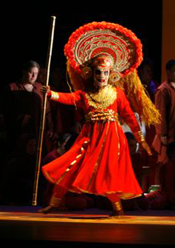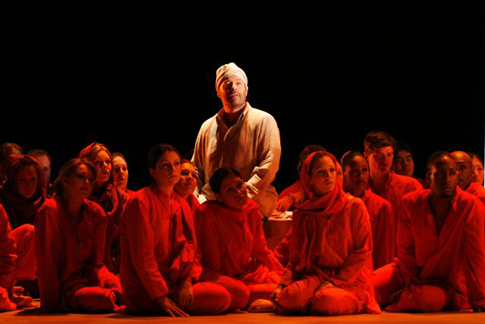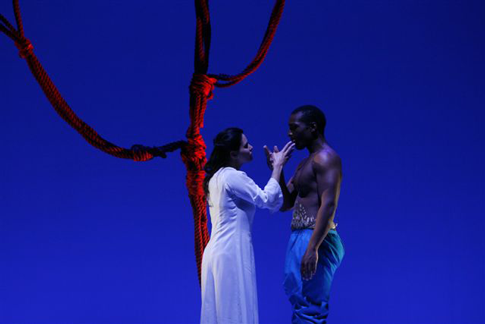![Kumudha (Natasha Jouhl) transforms into a flowering tree [Photo by Liz Lauren]](http://www.operatoday.com/a-flowering-tree.png)
28 May 2008
Tree-mendous in Chicago
Chicago Opera Theater scored a resounding success with its area premiere of John Adams’ newest stage piece, “A Flowering Tree.”
Upon its premiere at Chicago’s Lyric Opera in 1997 Anthony Davis’ Amistad found little critical favor. Its undisciplined excesses led one writer to compare it to a high-school pageant.
In these days of 'concept' productions, it is rare that the curtain goes up on the first act of an opera and it looks exactly as one might reasonably expect it to.
I can still remember my first ever “Pelleas et Melisande” in my first ever outing at San Francisco Opera during my first ever visit to that beautiful town.
A recent visit to Berlin’s three opera houses yielded decidedly, nay wildly varying outcomes.
The Gotham Chamber Opera has been delighting opera fans on the Lower East Side for seven years now, one small audience at a time.
Thirty-six years after Sarah Caldwell and the Opera Company of Boston presented the first complete staged performances in the United States, Hector Berlioz’ Les Troyens returned to Boston in triumph in a series of concert performances presented by the Boston Symphony Orchestra under the baton of James Levine to close the BSO’s 2007-2008 season.
Opera companies should practice historic preservation, keeping certain productions forever in the repertory because of their quality and aesthetic value.
Prometeo is so radically different that it’s almost incomprehensible heard from preconceived assumptions of what music “ought” to be.
John Brown might have been a’mouldering in his grave since he was hanged in 1859, but he was resurrected — in body and spirit — on May 3, when the Lyric Opera of Kansas City staged the world premiere of Kirke Mechem’s John Brown.
When Toronto’s Opera Atelier asked her to sing Elettra in Mozart’s Idomeneo Measha Brueggergosman hesitated.
In 2007 it was an experiment; now it’s a new summer festival firmly rooted in fertile Texas turf with a bright view of its second season and of the more distant future as well.
Die Entführung aus dem Serail is too light to be a grand opera, but it makes rather grander demands of its singers than operetta could possibly bear.
English National Opera’s production of Harrison Birtwistle’s ‘Punch and Judy’ is the company’s second collaboration with the Young Vic Theatre — following the premiere of Neuwirth’s ‘Lost Highway’ a few weeks earlier — and remarkably, also the second London production of this early Birtwistle work within a month, the previous one having been at the Linbury Studio Theatre, a collaboration between Music Theatre Wales and the Royal Opera.
Over the years, one tried and true method of packing audiences in to the concerts of Robert Bass’s Collegiate Chorale has been to present concert opera with impressive soloists.
Martha Graham used to say, “In order for there to be dance, there must be something that needs to be danced.”
When the Met presented La Fille du Régiment for Lily Pons during World War II, she sought permission to wave the Cross of Lorraine, symbol of Charles de Gaulle’s Free French, during the Salut à la France in Act II.
Why does one so seldom encounter Dvořák’s Rusalka on stage?
Satyagraha is an odd duck to encounter if you are seeking a traditional opera-going experience or anything like it.
Victor DeRenzi is a man of convictions — and of courage. Given his commitment to tradition, you might call DeRenzi, artistic director of Sarasota Opera since 1982, conservative.
At the curtain call for the first night of WNO’s new production of the infrequently performed Khovanshchina director David Pountney wore a simple Russian shirt.
![Kumudha (Natasha Jouhl) transforms into a flowering tree [Photo by Liz Lauren]](http://www.operatoday.com/a-flowering-tree.png)
Chicago Opera Theater scored a resounding success with its area premiere of John Adams’ newest stage piece, “A Flowering Tree.”
And it did so with a completely different take on the piece than that devised by Peter Sellars for Vienna’s world premiere in November 2006 at the Festival of New Crowned Hope.
The original concept had the large orchestra on stage, with minimal stage action relegated to small elevated playing spaces, more semi-staged oratorio than a full-fledged dramatic rendering. It is perhaps no accident that this Chicago company has “theater” prominently included in its name, for they have put the band back in the pit, and with consummate stagecraft, they fleshed out this folk tale’s libretto which was crafted by Sellars and the composer based on a story translated by A.K. Ramanujan from the Kannada language of southern India.
 The king (James Johnson, dancer).
The king (James Johnson, dancer).
The tale concerns two sisters, one of whom, “Kumudha,” is able to
transform herself into “A Flowering Tree” and back again. However, her
jealous sibling’s wicked friends break the spell, trapping the heroine in
her tree-state, breaking her limbs, and leaving her in the gutter as a
pitiful grub-like torso. After her disappearance, the “Prince,” having
already wedded her for her bewitching beauty and powers, wanders
disconsolately until his love restores her and reunites them in marital
bliss. The only other singing principal is a “Storyteller.”
The minimalist set and costume design by George Souglides scored big, with simple yet highly imaginative effects. The first important transformation scene was accomplished with “Kumudha’s” sister (dancer Karla Victum) stretching hidden, over-long sleeves from her costume and extending and twisting the “branches” into various shapes. Each subsequent transfiguration was larger then the previous, magically accomplished with colored ropes.
Whether descending from the flies or rising from the stage floor, these were presented in artfully tied designs that would be the envy of any advanced macrame class. Indeed, the curtain rise of Act Two stunningly coincided with a “growing tree” emanating from “Kumudha” down center stage that ultimately filled the entire proscenium opening. The few set pieces and props (a veil-covered over-sized wedding bed, a gilt throne, primitive masks on poles) were selected with attentive care.
 The Storyteller (Sanford Sylvan).
The Storyteller (Sanford Sylvan).
The evocative and colorful costume design was effectively based on
traditional Indian and Asian street and stage garb, with a couple of the
specialty dance turns being dazzlingly outfitted. I wish that same attention
had been lavished on our heroine, who looked quite plain; well, too plain by
comparison. Indeed, the rather lumpy and shapeless white coat she wore in the
wedding scene was promisingly removed to reveal only more of the same look,
if better fitted. All of this was well-served by Aaron Black’s terrific
lighting, artfully combining lustrous washes of color with well-calculated
and flawlessly executed specials, gobos, and area lighting.
If all this was gorgeous to behold, it would not have impacted us as strongly as it did without Nicola Raab’s masterful direction. First, without ever unduly cluttering the stage, Ms. Raab has devised meaningful and poetic movement for the large chorus and corps de ballet. As we entered the theatre, the white-garbed “Storyteller” was already seated, immobile on a chair stage right. Slowly, the chorus in reddish-orange filed on from various points and seated themselves on the stage around him, ultimately creating a visual “island” that captivates us before a note is played. We couldn’t wait to hear what he has to say.
Similarly, meaningful character relationships are defined with ethereal subtlety. The mating scene with our newlyweds walking/stalking on the bridal bed was a study in sensuous restraint, as the pair never quite touched but conveyed the impression of love-making nonetheless by tracing the head and torso with slow sweeping gestures, and intertwining their arms (well, almost) in ever inventive combinations.
Perhaps the most problematic scene of all, the dismemberment of the tree-trapped “Kumudha” was beautifully solved by having two dancers wrap her in a cocoon of a vibrant red cloth. Leaving one arm free, the actress could recline, sit up, and drag herself around the stage as a sympathetic outcast.
The ritualistic choreography by Renato Zanello was well-executed by not only his trained dancers, but also pleasingly performed by the singing chorus. The clean, thrilling choral work (most of them are in the COT Young Artists Program) was complemented by the group’s exceptional ability to transform themselves at will from commentators, to bystanders, to relatives, to royal subjects, all the while doing some amazing staged business, not the least of which was crawling from the wings on their bellies to pick up folded boards that were used in any number of combinations to create everything from a village of houses to a penultimate pop-up back-drop for the lovers’ reunion.
COT assembled a fine trio of singers as its principals. Natasha Jouhl proved an affecting “Kumudha,” singing with a well-schooled, ample lyric soprano that easily encompassed all the wide ranging demands and soaring lines of this difficult role. Originally written with Dawn Upshaw in mind, the part was taken over in Vienna (and several other locations) by rising star Jessica Rivera (who recently triumphed locally in another Adams piece, Chicago Lyric’s “Dr. Atomic”). Dawn and Jessica are two artists who really “get” this music and don’t just sing it, but embody it. That said, although she vocalized it splendidly, looked attractive, and acted with commitment, I did not yet feel that Ms. Jouhl has fully integrated the piece into her voice, or more particularly, her artistry. I would love to see her again after she has the experience of some more performances.
With Noah Stewart’s “Prince” I felt that we were experiencing an artist on the verge of a major career. He brought a regal bearing to the portrayal, and a polished, weighty lyric voice with excellent thrust on the high phrases, and wonderful presence throughout the range. Excellent diction, handsome good looks, beautiful instrument, wonderful musical instincts, sound technique, stage savvy — he’s got the goods.
I have long admired the fine artist Sanford Sylvan, but I found that his soft-grained approach was initially a little too lieder-based and subtle for the task at hand as the “Storyteller.” Seated a third of the way upstage for the first act, while I could hear his beautiful sounds and sensitive phrasing, I too often had real trouble understanding the text and found my gaze drifting to the surtitles. When he came forward to the side of the proscenium in Act Two, there was an immediate difference. This would be a quick fix by just telling him to “Sing out, Louise” when he is upstage. Still, he is a treasureable baritone and was an audience favorite.
 Kumudha (Natasha Jouhl) and the Prince (Noah Stewart).
Kumudha (Natasha Jouhl) and the Prince (Noah Stewart).
Diminutive Joana Carneiro had taken over conducting duties from Mr. Adams
and this was a tour-de-force assumption. “Tree” is a monster-piece that
calls for split second rhythmic changes, quicksilver mood-altering shifts,
lyrical outpouring, percussive tirades, and well, the kitchen sink just may
have been in there somewhere. Above all, this stuff must be clean-clean-clean
to make its hypnotic effect and save a few squishy moments in the opening
bars’ undulating strings, Ms. Carneiro was in full command of her forces.
As if she was driving a car at 120 miles an hour, there was no room for
error. And she negotiated every twist and turn of this challenging piece with
concentrated inspiration. Brava Maestra!
It seems as though Mr. Adams may have developed the score a bit since Vienna, where I remember thinking that perhaps the heroine should have a set piece up front to announce her character. It seems that “Kumudha” had more exposition to sing at COT. Or maybe the staging was just that much more compelling. For all its glories, and they are many and they are ravishing, I still found myself wishing that the long chanted choral dance in Act Two (sort of Rap-Lite) was a bit shorter. And I sorta wanted a radiant final duet for the reunited lovers. Have I seen “Turandot” too many times? Perhaps.
Still, this was in toto a welcome and notable achievement. Chicago is a world class musical city and with Chicago Opera Theater’s “A Flowering Tree” we have been treated to a sampling of the very best the town has to offer.
James Sohre